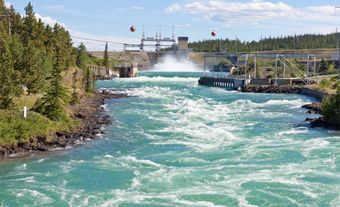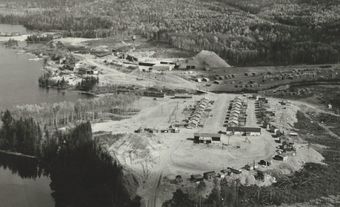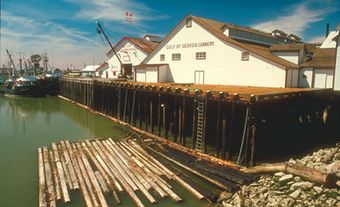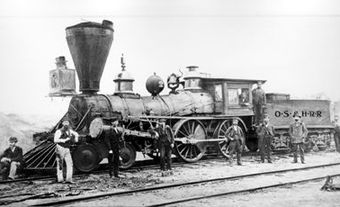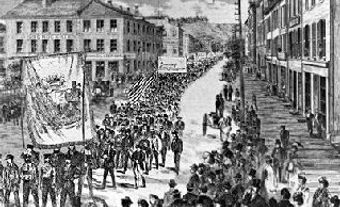Resource towns are small, isolated communities built around resource-based industries and transportation. They include mining towns, mill towns, railway towns and fishing villages. Resource development has long been a key factor in shaping the settlement and growth of communities. Some scholars have argued that all Canadian urban growth depends on the production of natural resources. (See also Staple Thesis.) Resource towns have been important agents in this production process. Because they depend on single industries, the economies of resource towns are often unstable.

Examples of Resource Towns in Canada
|
Town |
Resource |
|
Murdochville, Quebec |
|
|
Black’s Harbour, New Brunswick |
fish packing |
Shared Characteristics
In some respects, Canadian resource towns resemble similar towns throughout the world. These towns are based on the extraction or processing of resources such as minerals, forest products and hydroelectric power. Typically, the resource town is linked to an industry or business and lacks control over its own economic growth. The economic base is controlled by outside corporations or governments. These outside agents determine the nature and extent of the extractive or processing activity. In doing so, they also determine the size of the local workforce and the degree of local prosperity or growth.
Most resource towns do not share in the ultimate economic benefits derived from the resources. This is because raw materials are usually shipped elsewhere, often outside Canada, for processing. Boom and bust phases depend on shifts in the international market for resources, or on government or corporate decisions, rather than on local actions. This uncertainty can create feelings of insecurity and impermanence in the community. In mining towns, the knowledge that the resource base will eventually run out only adds to such feelings.
Resource towns are also characterized by their simplified occupational structures. The middle class is relatively weak. It usually includes only a small group of managers, merchants and professionals. The careers of these people are tied to organizations outside the town. Workers often migrate between resource towns in search of employment.
Several factors discourage the development of a diversified (varied) economy that would generate a more mixed workforce. Isolation from major markets, relatively high wages paid by resource industries, and high development costs combine to prevent the influx of secondary industry. One result is that there is often a high ratio of men to women in resource towns because there are fewer job opportunities for women.
Another result is that most (but not all) resource towns have a relatively small population. Therefore, they share many of the features of any small town, regardless of its economic base.
A final common characteristic is physical appearance. Recently built resource towns tend to resemble the new suburbs of large cities. Older towns are generally dominated by a mine or mill.
Distinctive Characteristics

Canadian resource towns have much in common with each other and with towns in other countries. However, they also have several distinctive characteristics. One basic distinction involves the origins of the population.
Local workers populate many of the resource towns of the Atlantic provinces and Quebec. They come from the surrounding fishing, lumbering and agricultural population. In sharp contrast, the workforce and management of the resource towns of Ontario and Western Canada come from well beyond the town or from outside the country. “New towns” created in largely uninhabited areas have no physical or cultural rural connections.
A second major distinction relates to the decision-making process that creates and maintains the community. Some towns arise from decisions made by a single company or a government. Others evolve from decisions made by several companies or by the townspeople themselves.
The two types of towns that result are service and supply towns (e.g., Sudbury, Ontario) and company towns (e.g., Témiscaming, Quebec). Service and supply towns sometimes begin as boom towns, meaning they form or grow with the sudden profitability of a commodity or activity. Company towns are generally small, static communities closely attached to one industry’s operation. Not all resource towns fall into one category or the other. For example, in the early 20th century, Glace Bay, Nova Scotia, was a boom town with a company-town monopoly over its coal industry. Glace Bay grew rapidly as its 11 collieries, owned by the Dominion Coal Company, drew thousands of workers, including new immigrants.
Town Planning

The townscape of resource towns depends on who plans and builds them.
The shaping of these towns has reflected different approaches to urban and regional planning in Canada over time. Three generations of resource towns have been built since Confederation. The first generation (1867–1920) consisted of privately built towns such as Cobalt, Ontario. The second generation (1920–39) saw a shift to holistically built towns such as Kapuskasing, Ontario. Since 1945, comprehensively planned towns such as Kitimat, British Columbia, have defined the third generation.
Resource-town building has greatly advanced since the first-generation towns appeared in the 19th century. The modernization of some of the larger service centres and the designs of some of the new towns illustrate this progress. But despite modernized planning concepts, the basic problems facing resource towns remain.
Many have a limited lifetime. Prospects for activity and growth beyond the initial function seldom materialize. In some cases, the resources simply run out. In other cases, market conditions change, or an international corporation moves its operation to another country. Mines or plants close and the town eventually dies (e.g., Pine Point, Northwest Territories and Schefferville, Quebec). Hundreds of Canadian communities have disappeared in this way. Sometimes industrial plants become obsolete. In all cases the future remains uncertain, and the boom-and-bust pattern plagues attempts for orderly, long-term development.

 Share on Facebook
Share on Facebook Share on X
Share on X Share by Email
Share by Email Share on Google Classroom
Share on Google Classroom

